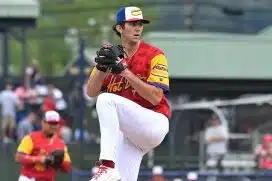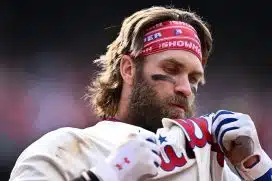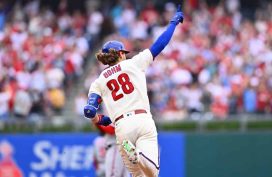Nick Williams (left) and Aaron Altherr (right) will likely battle for playing time in 2018. (Brandon Apter & Frank Klose/SportsTalkPhilly)
By Tim Kelly, Sports Talk Philly editor
When Matt Klentak and the Philadelphia Phillies signed Carlos Santana to a lucrative free-agent contract last month, it created an enviable problem – the Phillies have more than three outfielders capable of starting.
Santana will push Rhys Hoskins to left field, presumably on a close to full-time basis. Odubel Herrera, the first player that this regime signed to a long-term contract, is likely to get a majority of the starts in center field. That leaves both Nick Williams and Aaron Altherr – who were penciled in as corner outfield starters when it looked as though Hoskins would start at first base – to compete for time in right field.
In my first Opening Day lineup projection, Williams edged Altherr out as the starting right fielder. After all, Williams, who was a key piece in the July 2015 Cole Hamels trade, slashed .288/.338/.473 with a .344 wOBA, a 110 wRC+, 20 walks, 12 home runs and 55 RBIs in his first 313 major league at-bats. Even prior to the spark that Hoskins provided when he was called-up in August, Williams' late June call-up provided the Phillies with a much-needed offensive spark.
Will Williams follow up a strong first offensive stint at the major league level? Well, it depends who you ask.
Baseball Reference, which uses the Marcels projection system, thinks Williams will perform at a very similar level in 2018 as he did in 2017:
The Marcels projection system, even in the words of creator Tom Tango, is an imperfect system:
Actually, it is the most basic forecasting system you can have, that uses as little intelligence as possible. So, that's the allusion to the monkey. It uses 3 years of MLB data, with the most recent data weighted heavier. It regresses towards the mean. And it has an age factor.
In theory, this system makes quite a bit of sense for veteran players. The problem is that for a player like Williams, who has only played part of a season at the major league level, there aren't three years to draw off of. As Tango said, recent data is weighed heavier in all projections made by the Marcels projection system. The problem is that in Williams' case, all that exists is very recent data.
Other 2018 projections (some of which were done when it appeared both would be starting) aren't as kind to Williams. Steamer, used by FanGraphs, projects Williams will slash .256/.301/.443 with a .315 wOBA, a 91 wRC+, 22 walks, with 15 home runs and 53 RBIs (this is projected in a 380 at-bat season, as opposed to the 335 at-bat season used in the Marcels projection). ZiPS, another tool used by FanGraphs, predicts Williams will slash .252/.294/.448 with a .313 wOBA, a 90 wRC+, with 24 home runs and 91 RBIs (this system projects every player to have a maximum amount of plate appearances – Williams gets an unrealistic 613 plate appearances – which accounts for what appear to be eager home run and RBI numbers).
If the Marcel projection is correct, Williams will likely get a bulk of the starts in right field. When you consider that the counting numbers in the ZiPS projection are skewed, the other two projections don't look impressive at all. If he produces at a clip in-line with either of the two, Altherr, who will turn 27 next week, may end up starting more games in right field.
For what it is worth, the Marcels projection system doesn't project Altherr will have as good of a season as Williams in many regards, though that may simply be because he has more of a sample size at the major league level to work with:
Altherr's Steamer projection, by a small margin, is better than that of Williams. Steamer projects that Altherr will slash .250/.325/.448 with a .328 wOBA, a 100 wRC+, 32 walks, 18 home runs and 62 RBIs. His ZiPS projection would probably disappoint a lot of Phillies fans, but it remains better in many categories than Williams'. ZiPS projects that Altherr will slash .242/.313/.447 with a .322 wOBA, a 96 wRC+, 18 home runs and 69 RBIs (the counting numbers are lower, at least in part, because Altherr is projected to have 468 plate appearances, 145 less than Williams).
If both perform at a level similar to the latter two projects, it may come down to manager Gabe Kapler riding the hotter hand. If Altherr is hitting at the pace that he did last April – when he posted an .877 OPS – he'll start in right field. If Williams hits like he did in September, when he slashed .303/.328/.440, he'll start. The rest of the time, Kapler may mix-and-match in right field.
What other factors could come into play? In addition to some offensive concerns, Williams didn't grade out well defensively in 2017. In his first 83 major league games, Williams posted a -3.0 UZR, a -9.6 UZR/150 and -13 defensive runs saved (per FanGraphs). Altherr didn't grade out especially well either, but he did better than Williams, and unlike Williams, he doesn't have a history in the minor leagues of grading out poorly defensively.
Of course, Altherr is only going to be able to push for playing time if he's able to stay healthy, something he's had trouble doing in his brief time at the major league level. After tearing his sheath tendon in his left wrist in Spring Training, Altherr missed nearly the first four months of the 2016 season. In 2017, he had two stints on the disabled list with a right hamstring strain. Soft tissue injuries can be reoccurring or lead you to put more stress on other parts of your legs to compensate, neither of which is good for an outfielder. What's that old saying about availability being the best ability?
On top of Williams and Altherr, other outfielders could push for time in 2018. Andrew Pullin and Dylan Cozens very well could appear at the major league level in 2018. At the MLB Winter Meetings, general manager Matt Klentak hinted at the idea of Roman Quinn potentially being the team's fifth outfielder in 2018. (Klentak did something similar with Andrew Knapp last offseason, before Knapp made the team out of Spring Training.) Quinn's issues staying healthy – which make Altherr look like Cal Ripken Jr. – are well documented. But scouts remain high on Quinn when he's healthy, and he had a strong 57 at-bat stint with the Phillies in 2017. Quinn also walks at a much higher rate than Williams, something the Phillies like.
Phillies Nuggets: An Early Crack At The 2018 Opening Day Lineup
In theory, if Quinn is able to stay healthy, his best position is center field. So if Odubel Herrera is hurt or going through a cold spell – something he's prone to doing – Quinn could get some time in center field. But Herrera has graded out as one of the best fielding center fielders in the sport since 2015, and has the potential to carry an offense when he's on. He's going to get a majority of starts in center, as Hoskins probably will in left field. That means that if Quinn, who will turn 25 in May, is able to stay healthy, he could also push for time in right field.
Another thing worth monitoring is the success (or lack thereof) that Maikel Franco has. Even though he doesn't have a direct correlation on who plays in right field, if he struggles like he did in 2017, Kapler may feel the need to get Altherr's bat in the lineup more frequently, because he's a right-handed hitter with power. Conversely, if Franco has a strong 2018 campaign, it may lend itself to Williams playing more, or a more traditional platoon.
The Phillies have come quite a way in a few years organizationally, as this outfield depth shows. With Altherr injured, Cedric Hunter and Peter Bourjos joined Herrera in the 2016 Opening Day lineup. Even last year, Herrera was joined by Howie Kendrick and Michael Saunders in the Opening Day outfield, both of whom are currently free-agents. In 2018, Kapler will have as much outfielding talent to work with as any Phillies manager has since Charlie Manuel. How he pleases all the talent and gets the most out of each player will be a key test in his first year at the helm.







